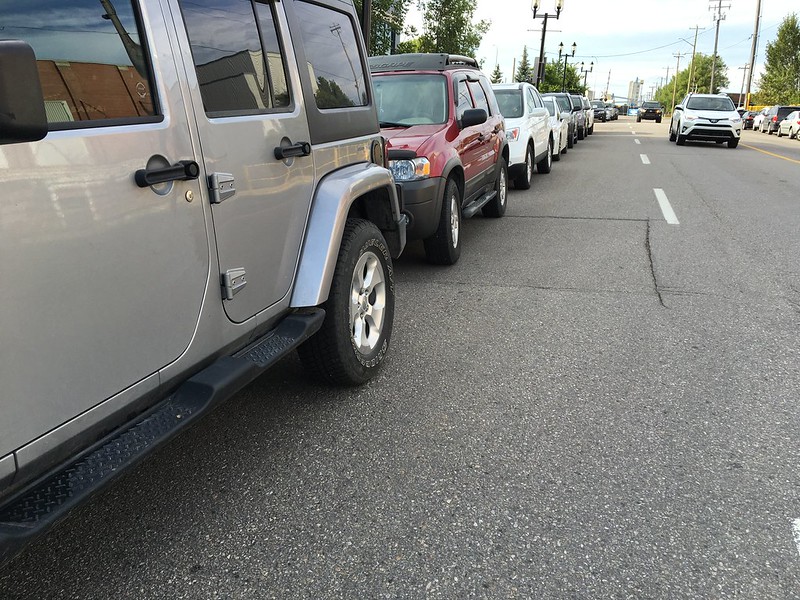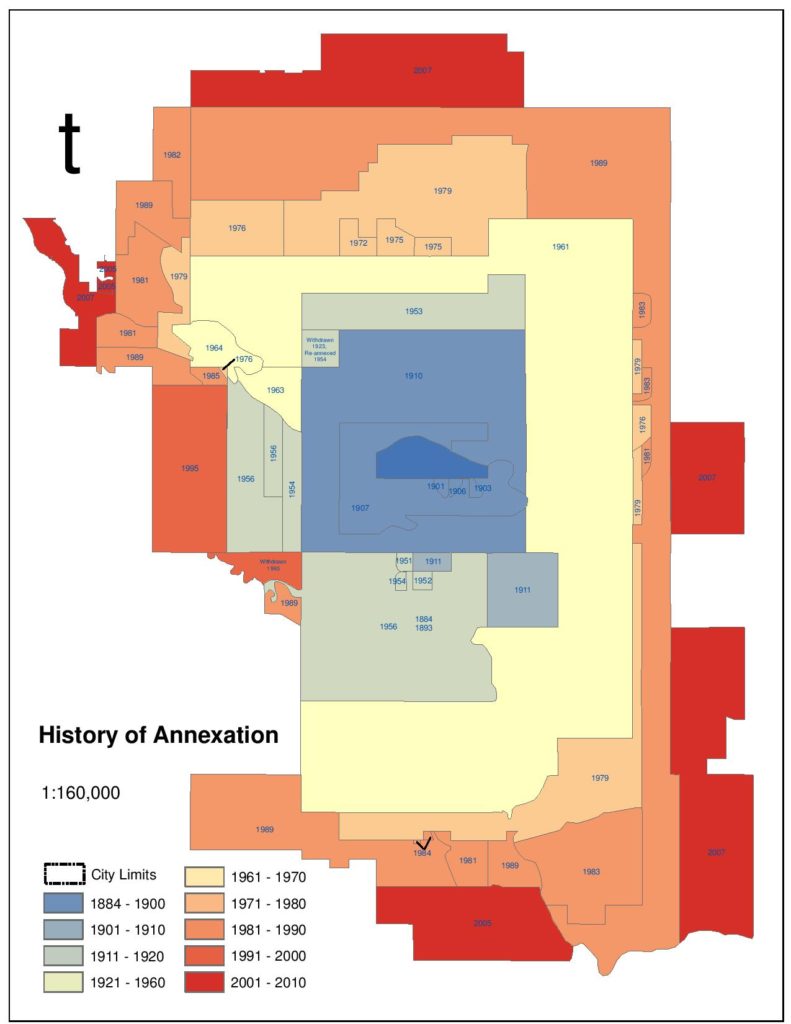You’ve been there, even if you haven’t consciously been there: Riding your bike down a typical city street feeling squeezed from all sides, unable to see past the next intersection, worried about being doored and generally unwelcome on what should be public space.
Why do you feel that way? Because the street looks like this:
 There’s nothing wrong, technically, with this street. These scenes are everywhere. But the reason you feel all those things is so obvious it’s almost invisible. There are cars everywhere. And I mean everywhere. Crammed along the curbs, congested on the street, taking up space everywhere.
There’s nothing wrong, technically, with this street. These scenes are everywhere. But the reason you feel all those things is so obvious it’s almost invisible. There are cars everywhere. And I mean everywhere. Crammed along the curbs, congested on the street, taking up space everywhere.
I know you know this. Like me, you’ve read all the statistics about the increasing number of cars on our streets. But maybe you were like me and didn’t really stop to think about what that means to your everyday bicycle commute.
What opened my eyes was a comment from a reader named Stu on my piece a couple of weeks ago about vehicular cycling. Here is part of Stu’s comment.
I can barely remember 1976, but what I do remember is that I could bike down most streets and not encounter a motor vehicle. Today it is the (opposite), no matter how ‘residential’ the street, the chance of not meeting up with a MV is slim. Times have changed, everyone seems to own a car or two and they use them for even the shortest of trips.
Something about Stu’s comment stuck in my head. I started imagining my bicycle commute in 1976. I’d be riding a steel-framed 10-speed in tiny shorts and knee socks, my feathered hair unencumbered by a helmet, and I would pass down a residential street with no cars. It’s almost unimaginable (not the hair, the image of a street with no cars).
So I did some digging into the impacts of increasing car ownership rates on the physical space in a city. Beware incoming numbers:
I live in Calgary, Canada. Back in 2008, the number of registered motor vehicles in the city was 829,030, according to this. By 2015, that number had grown to 1,005,109, according to this. That’s an increase of 176,079 vehicles in about seven years.
Think about how much space that takes up in a city. If each vehicle is, say, five metres by two metres (that’s an estimate, mostly to make the math easier, but it’s in the ballpark), that’s 10 square metres we’ve lost for each of those vehicles. I know they aren’t all on the road at the same time, but no matter how you slice it, occupying 10 square metres more than 175,000 times is a lot of space — 1.76 square kilometres, to be exact.
There’s more. According to the 2011 census, the size of Calgary is 704.51 square kilometres. For the sake of argument, let’s say that number didn’t change much between 2008 and 2015 (the city has grown, but not by much: Calgary’s wise but belated push to reduce sprawl, like basically every other city in North America, means there hasn’t been a big annexation since 2011, and the last major one was in the early 2000s).

That means the number of cars per square kilometre had grown to 1,426 in 2015, from 1,176 in 2008.
Think about the square kilometre around your house, and then imagine cramming in an average of 250 more cars in that space. Guess what? That happened over the last seven years, and you probably didn’t realize it.
Here’s one more thing to think about. I couldn’t find car ownership rates going back to 1976 to test Stu’s memory. But I did find this fascinating study from NYU, which compared vehicle ownership rates around the world between 1960 and 2002. In Canada in 1960, the number of vehicles per 1,000 people was 292. By 2002, that had climbed to 581. Based on a 2015 population of 1,230,915, the number of vehicles per 1,000 people in Calgary in 2015 was a whopping 816.
That isn’t an entirely apples-to-apples comparison, so I wouldn’t base your Ph.D thesis on it, but it does give you an idea of how many more motor vehicles are on the roads these days, and it’s a safe bet a similar story is playing out in other North American cities.
It also helps explain why you sometimes feel like an alien, unwelcome and pushed around, on your own street, when you ride a bicycle.
A well-functioning society of course needs motor vehicles, but Stu, it seems was right — our streets are much different now than they were just a few years ago, never mind back in 1976.
Much of this has happened unconsciously, so maybe a first step in making our cities more friendly is to start thinking about what enabled all those cars, and to take the steps necessary to curb the growth of car-ownership. We all, after all, have to share that space.
Follow Shifter on Facebook or Twitter. Follow Tom Babin on Facebook, Twitter or Instagram.
About 5 decades ago, there were 100 mph sections on the Trans Canada highway through the prairies. A simple thing like a flat tire or gusting wind at that speed usually proved deadly.
A few years later, speeds were lowered to 70 mph and eventually to 100-110 kph. However, in the mean time car handling and horsepower has been improved until today where we have cars putting around cities with several hundred horsepower. The improvement in handling leads people to over confidence. Cars no longer struggle to do 100 mph.
People also spend more time driving and are starting to resent how much of their free time is required to get through rush hour.
Driving has become more stressful as cities struggle to accommodate the automobile and all the demands this entails.
An interesting thing happens when people switch to bicycles and work closer to home. The exercise, reduced travel time and time to relax during commutes helps people handle normal stresses better. The end result is less impatience to endanger other lives in order to be somewhere else or to get somewhere faster.
Bicycle commuting changes people’s perceptions but it also makes us more aware how deadly impatience on the roads used to be when we were the ones who resented having so little free tine to enjoy life.
A well-functioning society needs far fewer motor vehicles. Obviously, it needs ambulances, fire trucks, public transport vehicles (on road and rail) and delivery vehicles (including farmers taking food to markets) but it sure as hell doesn’t need anywhere near the number of private cars clogging up our cities, killing people, pets and wild animals and fouling our air as is found these days.
It isn’t the few people driving in rural and wilderness areas who are contributing much to this lethal mess; it is people in cities and their suburban sprawl.
This is a really interesting topic, but I’m not sure about this analysis. Many kilometers of new street were also built to move/store those cars in that same time frame. Certainly there are more parked cars in some neighbourhoods, but possibly less in others, as demographics change.
In the 1970s, some neighbourhoods would’ve had 2 adults and 4 kids, with anywhere from 1-3 or more cars, housed on a 50′ lot. That same lot may now be two dwellings on 25′ each, but with 4 adults and maybe 2-3 kids and perhaps 3-5 cars (across the two lots together). Hard to say how that’s changed, and how changes in use of garages has occurred, too. Were folks in the 1970s more or less likely to use their garages for parking than we are today? Was the man cave a thing in the 1970s?
Here’s a link that really gets at the dynamics of how a city can grow (on the edges and maybe in the core) and shrink (in the inner suburbs) at the same time – this is a key nuance for what you’re arguing here. http://www.thetransportpolitic.com/2016/07/06/reorienting-our-discussion-of-city-growth/
I’d also try to dig up some data on how many lane kilometers of road the city has added throughout all those annexations. It’d be curious to know the ratio of vehicles to lane kilometers over time, though as per above it’d be pretty uneven throughout town…
I’m trying to square your research against several articles on less of the younger generation(s) of legal driving age, not owning a car or having a car license.
http://www.macleans.ca/economy/business/young-and-carless/ Are these just urban observations vs. the whole of Canada?
Or the auto industry trying to still lasso in future younger purchasers.
Yes, I think the trend away from car ownership among young people is real, but I remain skeptical about the long-term trend in that direction, as much as I would like to see it borne out. From what I’ve seen so far, that decline in ownership among young people has not made much of a dent in overall car sales or ownership growth. That may play out in the long run, but other factors, such as self-driving cars, will also have an impact.
The LA Times piece would have made far more sense had you discussed the changes in car density and urban design since Forester’s book came out in the 1970’s. I was in my twenties back then and indeed, there were far fewer cars on the road and thus far fewer negative interactions with motorists. Its traffic density that restricts movement, resulting bad tempers, and bad urban design that is making vehicular cycling or for that matter sharing the road far more difficult. Plus, add distracted driving to the mix.
When I was in Calgary in 2005 I wrote up how the old city was so much easier to bike around in than the new arterial-and-cul-de-sac developments. Design matters.
VC works within a context. When that context is not relevant, as it may not be in many urban areas and some badly designed suburban ones, we obviously need something else and that is where separate space, when available, shines. But we should not throw out the idea of training someone to be a good cyclist, even if we have separate infrastructure. It should not be an A vs. B dichotomy. The horse is not dead, even if you kicked it pretty hard.
I do agree that any advocacy that treats VC or for that matter “paint and path” as dogma rather than as separate tools to a good end needs to be challenged.
I think…it’s the high time to mark a bike lane on each busy road. It will reduce the problem.
Thanks for sharing your opinion.